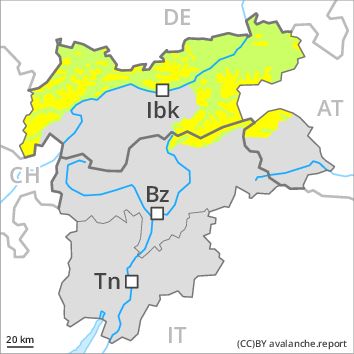Regions
Southern Adamello, Primiero - Pale di S. Martino, Adamello - Presanella, Northern Brenta - Peller, Southern Brenta, Fassa Valley, Sole, Pejo and Rabbi, Southern Lagorai, Northern Lagorai, Maddalene, Paganella, Pine' - Mocheni Valley

Danger level
Danger Level 3 - Considerable above the treeline
Danger Level 2 - Moderate above the treeline
Avalanche Problem
Wind-drifted snow above the treeline, N-NE-E-SE-S-SW-W-NW
Wet snow above the treeline, SE-S-SW-W

Wind slabs require caution. The danger of moist avalanches will increase a little during the day.
As a consequence of fresh snow and strong wind the wind slabs will increase in size additionally. The avalanche prone locations are to be found in particular adjacent to ridgelines and in gullies and bowls and on wind-loaded slopes. Single winter sport participants can release avalanches in some places, including medium-sized ones. As a consequence of warming during the day and the solar radiation, the likelihood of dry and moist avalanches being released will increase in particular on very steep sunny slopes at low and intermediate altitudes.
Avalanches can in very isolated cases be released in the old snowpack, in particular at transitions from a shallow to a deep snowpack. Whumpfing sounds and the formation of shooting cracks when stepping on the snowpack indicate the danger. Restraint is advisable on this first sunny day.
Snowpack
dp 6: cold, loose snow and wind
In some localities 10 to 20 cm of snow, and even more in some localities, fell above approximately 1000 m. The wind will transport the fresh snow. In some cases the various wind slabs have bonded still only poorly with each other and the old snowpack. The snowpack will be subject to considerable local variations. Isolated avalanche prone weak layers exist in the snowpack in particular in the vicinity of peaks.
Tendency
As a consequence of northerly wind, further wind slabs will form.
Regions
Western Verwall Mountains, Eastern Verwall Mountains, Northern Zillertal Alps, Allgäu Alps, Silvretta, Venediger Range, Eastern Lechtal Alps - Ammergau Alps, Southern Zillertal Alps and High Tauern, Mieming Mountains, Karwendel Mountains, Eastern Tuxer Alps, Brandenberg Alps, Western Kitzbühel Alps, Wilder Kaiser Mountains - Waidring Alps, Eastern Kitzbühel Alps, Western Lechtal Alps, Central Lechtal Alps

Danger level
Danger Level 2 - Moderate above 2200m
Danger Level 1 - Low above 2200m
Avalanche Problem
Wind-drifted snow above 2200m, N-NE-E-SE-NW

Fresh wind slabs at high altitude. On extremely steep slopes mostly small loose snow avalanches are possible.
As a consequence of fresh snow and a sometimes strong wind from northwesterly directions, wind slabs will form. These can be released by a single winter sport participant in isolated cases at high altitudes and in high Alpine regions. The avalanche prone locations are to be found in particular on very steep shady slopes above approximately 2200 m and adjacent to ridgelines. At high altitudes and in high Alpine regions the avalanche prone locations are more prevalent and larger. Such avalanche prone locations are clearly recognisable to the trained eye.
In addition as the day progresses some mostly small loose snow avalanches are possible. On sunny slopes the avalanche prone locations are more prevalent.
Snowpack
dp 6: cold, loose snow and wind
dp 9: graupel blanketed with snow
10 to 20 cm of snow, and even more in some localities, will fall. The northwesterly wind will transport the snow. In some places fresh snow and wind slabs are lying on soft layers. This applies in particular on shady slopes at high altitudes and in high Alpine regions. The no longer entirely fresh wind slabs have bonded quite well with the old snowpack in all aspects. The old snowpack will be generally stable.
Tendency
The avalanche danger will persist.
Regions
Sexten Dolomites, Latemar, Val Müstair Alps, Langtaufers, Schnals Ridge, Southern Stubai Alps, Samnaun Mountains, Northern Oetz and Stubai Alps, Saldurn-Mastaun Ridge, Western Tuxer Alps, Texel Mountains, Sarntal Alps, Western Pfunderer Mountains, Bondone and Stivo, Glockturm Range, Folgaria - Laverone, Eastern Pfunderer Mountains, Durreck Range, Weißkugel Range, Western Rieserferner Mountains, Gurgler Range, Western Deferegger Alps, Central Stubai Alps, Ortler Range, Ulten Valley, Eastern Nonsberger Alps, Eastern Rieserferner Mountains, Northern Dolomites of Fiemme, Glockner Range, Gröden Dolomites, Eastern Deferegger Alps, Prags Dolomites, Prealps, Schober Mountains, Cembra Valley, Lienzer Dolomites, Vallarsa, Western Nonsberg Alps, Grieskogel Mountains, Ledro Valley, Marzola - Valsugana

Danger level
Danger Level 2 - Moderate above 2200m
Danger Level 1 - Low above 2200m
Avalanche Problem
Wind-drifted snow above 2200m, N-NE-E-SE-NW

Fresh wind slabs at high altitude. On extremely steep slopes mostly small loose snow avalanches are possible.
As a consequence of a sometimes strong wind from northwesterly directions, wind slabs will form. These can be released by a single winter sport participant in isolated cases at high altitudes and in high Alpine regions. The avalanche prone locations are to be found in particular on very steep shady slopes above approximately 2200 m and adjacent to ridgelines. In some cases the avalanches are medium-sized. At high altitudes and in high Alpine regions the avalanche prone locations are more prevalent and larger. Such avalanche prone locations are clearly recognisable to the trained eye.
In addition as the day progresses some mostly small loose snow avalanches are possible. On sunny slopes the avalanche prone locations are more prevalent.
Snowpack
dp 6: cold, loose snow and wind
dp 9: graupel blanketed with snow
The northwesterly wind will transport the fresh snow. This applies at high altitudes and in high Alpine regions. In some places fresh snow and wind slabs are lying on soft layers. This applies in particular on shady slopes at high altitudes and in high Alpine regions. The snowpack will be subject to considerable local variations. The old snowpack will be in most cases stable.
Tendency
The avalanche danger will persist.



